Inner Circle |
|||||||||||||||||||
 |
 |
||||||||||||||||||
Knitted sweater with round yoke in DROPS Karisma or DROPS Merino Extra Fine. Piece is knitted top down with Nordic pattern. Size: S - XXXL Knitted hat in DROPS Karisma or DROPS Merino Extra Fine. Piece is knitted in the round with Nordic pattern.
DROPS 196-23 |
|||||||||||||||||||
|
---------------------------------------------------------- EXPLANATION FOR THE PATTERN: ---------------------------------------------------------- PATTERN: Sweater: See diagram A.1. Hat: See diagrams A.2 and A.3. Choose diagram for desired pattern. Work all stitches in stockinette stitch. KNITTING TIP (applies to multi-colored pattern): To avoid the knitting gauge to tighten when working pattern, it is important not to tighten the strands on back side of piece. Switch to a higher needle number when working pattern if the pattern is somewhat tight. ELEVATION: Insert a marker thread in first stitch on round (= mid back). Begin from right side and knit 11-11-12-13-13-14 stitches past marker thread, turn, tighten yarn and purl 22-22-24-26-26-28 stitches. Turn, tighten yarn and knit 33-33-36-39-39-42, turn, tighten yarn and purl 44-44-48-52-52-56. Turn, tighten yarn and knit 55-55-60-65-65-70, turn, tighten yarn and purl 66-66-72-78-78-84, turn and knit until beginning of round. DECREASE/INCREASE TIP (evenly): To calculate how to decrease/increase evenly, use the total number of stitches on row (e.g. 108 stitches) and divide stitches by number of decreased/increases to be done (e.g. 16) = 6.8. In this example work approx. every 6th and 7th stitch together. When increasing make 1 yarn over after every approx. 7th stitch. On next round work yarn overs twisted to avoid holes. INCREASE TIP (applies to sides of body): Work until 2 stitches remain before marker thread, make 1 yarn over, knit 4 (marker thread is in the middle of these 4 stitches), make 1 yarn over (= 2 stitches increased). On next round knit yarn overs twisted to avoid holes. DECREASE TIP (applies to sleeves): Decrease 1 stitch on each side of marker thread as follows: Work until 3 stitches remain before marker thread and knit 2 together, knit 2 (marker thread is between these stitches), slip 1 stitch knitwise, knit 1, pass slipped stitch over stitch worked. ---------------------------------------------------------- START THE PIECE HERE: ---------------------------------------------------------- SWEATER - SHORT OVERVIEW OF THE PIECE: Worked in the round on circular needle from mid back, work top down. Work sleeves in the round on double pointed needles/a short circular needle. NECK EDGE: Cast on 108-116-120-124-128-132 stitches on circular needle size 3 mm / US 2.5 with light gray green. Knit 1 round. Switch to beige brown. Now work rib = knit 2/purl 2 until piece measures 3 cm / 1". Knit 1 round while decreasing 16-19-19-20-20-20 stitches evenly - read DECREASE/INCREASE TIP = 92-97-101-104-108-112 stitches. Knit 1 round while increasing 20-22-32-36-39-42 stitches evenly = 112-119-133-140-147-154 stitches. Switch to circular needle size 4 mm / US 6. For better fit work an elevation at the back of neck so that yoke is somewhat higher on back piece. This elevation can be skipped, to make the neck the same at the front and back - read ELEVATION. YOKE: Now work pattern A.1 (= 7 stitches) 16-17-19-20-21-22 repetitions on round (begin at your size in diagram) - read KNITTING TIP and REMEMBER THE GAUGE! Continue pattern in the round like this. When entire A.1 has been worked vertically there is 288-306-342-360-378-396 stitches on round. Piece should now measure 23-24-24-24-24-24 cm / 9"-9⅜"-9⅜"-9⅜"-9⅜"-9⅜". Size S is now done, continue with next section below. Continue as follows in size M, L, XL, XXL and XXXL: Size M, L and XL: Work in stockinette stitch with beige brown until piece measures 25-27-28 cm / 9 ¾"-10⅝"-11" from cast-on edge, AT THE SAME TIME when piece measures 24-24-24 cm / 9⅜"-9⅜"-9⅜" increase 14-6-20 stitches evenly = 320-348-380 stitches. Continue with next section below. Size XXL and XXXL: Work in stockinette stitch with beige brown until piece measures 30-32 cm / 11 ¾"-12 ½" from cast-on edge, AT THE SAME TIME when piece measures 24-24 cm / 9⅜"-9⅜" increase 11-14 stitches evenly and when piece measures 27-29 cm / 10⅝"-11⅜" increase 11-14 stitches evenly = 400-424 stitches. Continue with next section. ALL SIZES: Work next row as follows: Work 42-46-50-56-60-65 stitches as before (= half back piece), slip the next 60-68-74-78-80-82 stitches on a stitch holder for sleeve, cast on 8-8-10-10-12-14 new stitches on row (= in the side under sleeve), work 84-92-100-112-120-130 stitches (= front piece), slip the next 60-68-74-78-80-82 stitches on a stitch holder for sleeve, cast on 8-8-10-10-12-14 new stitches on row (= in the side under sleeve) and work the 42-46-50-56-60-65 stitches as before (= left front piece). Finish body and sleeves separately. NOW MEASURE PIECE FROM HERE! BODY: = 184-200-220-244-264-288 stitches. Insert a marker thread in each side, in the middle of the 8-8-10-10-12-14 new stitches cast on under sleeve in each side = 92-100-110-122-132-144 stitches between marker threads on both front and back piece. Work stockinette stitch in the round with beige brown. When piece measures 2 cm / ¾" from division, increase 1 stitch on each side of both marker threads - read INCREASE TIP (= 4 stitches increased). Increase like this every 6th row (approx. 2 cm / ¾") 10 times in total in each side = 224-240-260-284-304-328 stitches. When piece measures 24-24-24-25-25-25 cm / 9⅜"-9⅜"-9⅜"-9 ¾"-9 ¾"-9 ¾" from division, knit 1 round while increasing 60-64-68-72-76-84 stitches evenly = 284-304-328-356-380-412 stitches. Switch to circular needle size 3 mm / US 2.5 and work rib = knit 2/purl 2 for 4 cm / 1½". Bind off with knit over knit and purl over purl but to avoid at tight bind-off edge make 1 yarn over after every 4th stitch (bind off yarn overs as stitches). Sweater measures approx. 54-56-58-60-62-64 cm / 21¼"-22"-22¾"-23⅝"-24⅜"-25¼" from shoulder and down. SLEEVE: Slip the 60-68-74-78-80-82 stitches from stitch holder in one side of piece on a short circular needle size 4 mm / US 6/double pointed needles and pick in addition up 1 stitch in each of the 8-8-10-10-12-14 new stitches cast on under sleeve = 68-76-84-88-92-96 stitches on needle. Insert 1 marker thread in the middle of the 8-8-10-10-12-14 stitches (= mid under sleeve). Work stockinette stitch in the round with beige brown. When piece measures 2 cm / ¾" from division, decrease 2 stitches mid under sleeve - read DECREASE TIP. Decrease like this every approx. 8th-6th-5th-4th-4th-4th round 12-15-18-19-20-21 times in total = 44-46-48-50-52-54 stitches. When sleeve measures 38-36-35-34-33-31 cm / 14⅞"-14⅛"-13 ¾"-13⅜"-13"-12⅛" from division (shorter measurements in the larger sizes because of longer yoke), knit 1 round while increasing 12-14-16-18-20-22 stitches evenly = 54-60-64-68-72-76 stitches. Switch to double pointed needles size 3 mm / US 2.5. Work rib in the round = knit 2/purl 2 for 4 cm / 1½". Bind off with knit over knit and purl over purl but to avoid at tight bind-off edge make 1 yarn over after every 4th stitch (bind off yarn overs as stitches). Sleeve measures approx. 42-40-39-38-37-35 cm / 16 ½"-15 ¾"-15 ¼"-14⅞"-14 ½"-13 ¾" from division and down. Work the other sleeve the same way. ---------------------------------------------------------- HAT - SHORT OVERVIEW OF THE GARMENT: Worked in the round on circular needle. Switch to double pointed needles when needed. There are 2 different diagrams for hat. If you want pattern with a big tree work according to diagram A.2 and if you want the pattern with a small tree work according to diagram A.3. Cast on 124 stitches on circular needle size 3 mm / US 2.5 with beige brown. Knit 1 round. Switch to light gray green. Work rib = knit 2/purl 2 for 4 cm / 1½". Switch to circular needle size 4 mm / US 6, knit 1 round while decreasing 16 stitches evenly - read INCREASE/DECREASE TIP (evenly) = 108 stitches. Now work pattern A.2 or A.3 – choose diagram for large or small tree (= 18 stitches) 6 times in total on round. REMEMBER THE GAUGE! When entire A.2/A.3 have been worked vertically, there are 12 stitches on row. Cut the yarn and pull it through the remaining stitches on needle, tighten tog and fasten. Hat measures approx. 24 cm/9½". |
|||||||||||||||||||
Diagram explanations |
|||||||||||||||||||
|
|||||||||||||||||||
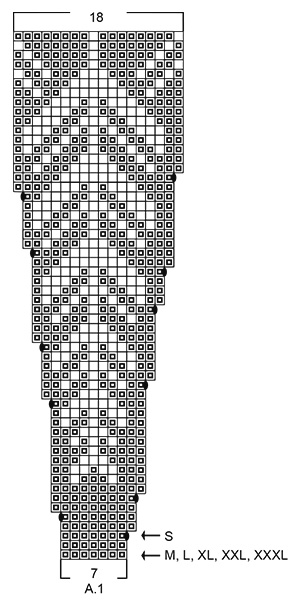
|
|||||||||||||||||||
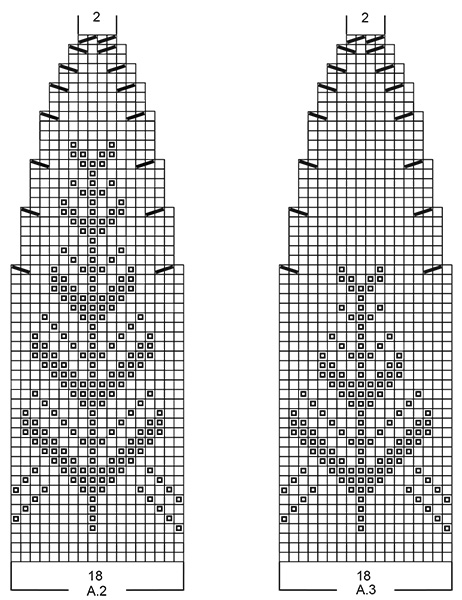
|
|||||||||||||||||||
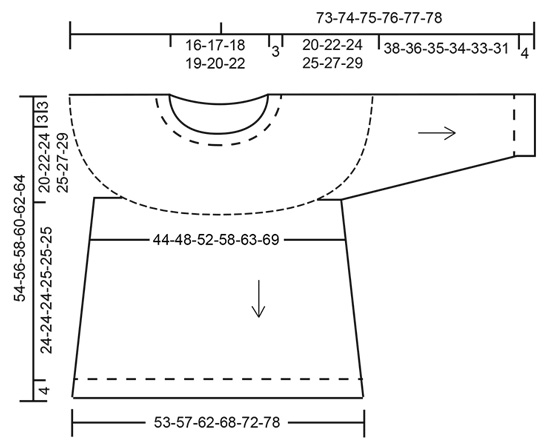
|
|||||||||||||||||||
|
Have you made this or any other of our designs? Tag your pictures in social media with #dropsdesign so we can see them! Do you need help with this pattern?You'll find tutorial videos, a Comments/Questions area and more by visiting the pattern on garnstudio.com. © 1982-2024 DROPS Design A/S. We reserve all rights. This document, including all its sub-sections, has copyrights. Read more about what you can do with our patterns at the bottom of each pattern on our site. |
|||||||||||||||||||







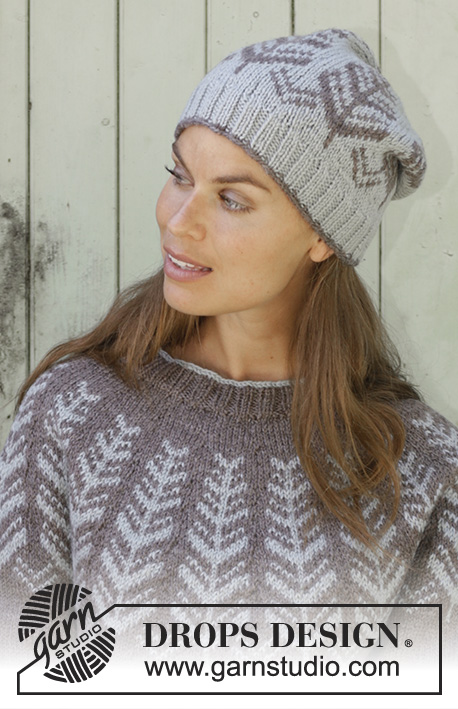



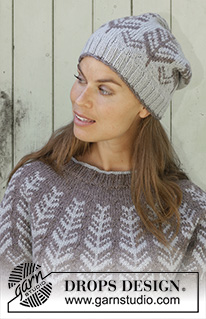





























































Comments / Questions (62)
Ska börja sticka nu. Läser igenom mönstret o undrar. Efter resåren vid halsen ska man minska 19 maskor, efter 1 varv skan man öka 20 maskor. Varför?
10.02.2023 - 15:55DROPS Design answered:
Hei Monika. Om du minsker masker etter vrangborden for deretter å øke maskeantallet vil du få bedre hold i halsen. Halsen/ vrangborden vil ikke sige så mye utover. mbh DROPS Design
13.02.2023 - 10:41Under ærmer står der at man skal have 44 masker efter indtagningerne i størrelse S, derefter strikkes en omgang ret hvor der tages 12 masker ud jævnt fordelt, der må være en fejl i størrelse S for jeg er nu ret sikker på at 44+12 ikke giver 54 som står i opskriften, men 56 :))
11.01.2023 - 12:45Adding those 60.extras (for size S) seems to be a mistake. My jumber ended wider than a skirt. 284 stitches does not give 53cm but over 70. ... ?
08.01.2023 - 18:08DROPS Design answered:
Witaj Ewo, tą część ze zwiększoną liczbą oczek przerabiasz ściągaczem, więc nie możemy do niej stosować próbki podanej we wzorze. Oczka dodane przed ściągaczem mają sprawić, że szerokość swetra na całej długości jest taka sama. Jeżeli ten efekt Ci nie odpowiada możesz dodać mniej oczek. Jak nie dodasz oczek w ogóle, to sweter będzie miał kształt bombki. Pozdrawiamy!
09.01.2023 - 09:39Hej! Hjälp! Jag har köpt garn och har börjat försöka sticka Inner Circle DROPS 196-23 DROPS Design: Modell u-869 Garngrupp B och nu skall jag börja sticka rapport/mönster A1. Jag förstår då inte hur många maskor det skall vara emellan varje rapport/mönster A1 på första varvet? Hur skall man komma på det, skall man räkna baklänges eller vad har jag missat. Snälla, hjälp! Med bästa hälsningar Agneta
25.12.2022 - 16:52DROPS Design answered:
Hei Agneta. Det skal ikke være noen masker mellom hver rapport av A.1. Les i oppskriften hvor mange rapporter av diagrammet du skal strikke i den str. du strikker etter. I f.eks str. S skal du strikke A.1 16 ganger etter hverandre (16 rapporter av A.1 som har 7 masker) = 112 masker. I str. S øker du også 1 maske i hver rapport på første omgang = 112 masker + 16 økte masker = 128 masker. Når du har strikket A.1 1 gang i høyden har du også økt på 11 pinner 16 ganger = 288 masker. mvh DROPS Design
02.01.2023 - 11:05I opskrift 196-23 skal der på første pind efter hals ribkant tages 19 masker ud. På næste pind skal der 20 masker ind. Hvorfor ??
21.07.2022 - 19:03DROPS Design answered:
Hej Uffe, det har design valgt at gøre for at markere overgangen :)
03.08.2022 - 15:32Bonjour, Je vous contacte aujourd’hui car je ne comprends pas la phrase ni ne vois comment procéder : « Relever en plus 1 maille dans chacune des 8 mailles montées… » PS: je suis fan de vos modèles et de vos laines Merci
21.02.2022 - 12:06DROPS Design answered:
Bonjour Axelle et merci :) Dans cette leçon, nous montrons comment tricoter un pull de haut en bas, et la photo 18 B) montre comment on va relever 1 maille dans chacune des mailles montées sous la manche. Bon tricot!
21.02.2022 - 13:23Thank you!!
21.01.2022 - 20:38Can you explain how to.. All Sizes "work next row as follows from wrong side"
21.01.2022 - 01:01DROPS Design answered:
Dear Mrs Cardeiro, it looks like there is a mistake in the US-English pattern, you are supposed to work this round from the right side since you are working in the round, pattern will be edited, thanks for your feedback. Happy knitting!
21.01.2022 - 09:09Hej Jag har köpt för lite garn till tröjan.Finns det möjligen färg nr 4, färgbad 53468 i drops merino extra fine?
16.01.2022 - 17:49Hallo, ich liebe eure Anleitungen wirklich! Aber hier bin ich ratlos. Ich habe bisher den Rumpf fertig gestrickt. Schon beim Abteilen der Ärmel kam es mir so vor, als habe ich viel zu viele Maschen am Rückenteil. ein paar habe ich direkt unauffällig abgenommen. Jetzt ist der Rumpf fertig und ich habe am Rücken immer noch zu viel. Es macht schon fast Falten. Vorne an der Brust sitzt der Pullover perfekt. Gibt sich das nach dem Waschen und Blocken? Danke für eure Hilfe!
03.01.2022 - 13:09DROPS Design answered:
Liebe Cora, stimmt Ihre Maschenprobe nicht? Normaleweise haben haben Sie genauso viele Maschen für das Rückenteil (halb am Anfang der Runde, halb am Ende) wie für das Vorderteil. Washcen und spannen bzw blocken hilft immer die Maschen mehr regelmäßig auszusehen. Im Notesfall zeigen Sie Ihrem DROPS Laden Ihr Strickstück so kann man dort Ihnen am besten helfen (auch ein Foto können Sie immer per E-Mail senden). Viel Spaß beim stricken!
03.01.2022 - 14:06